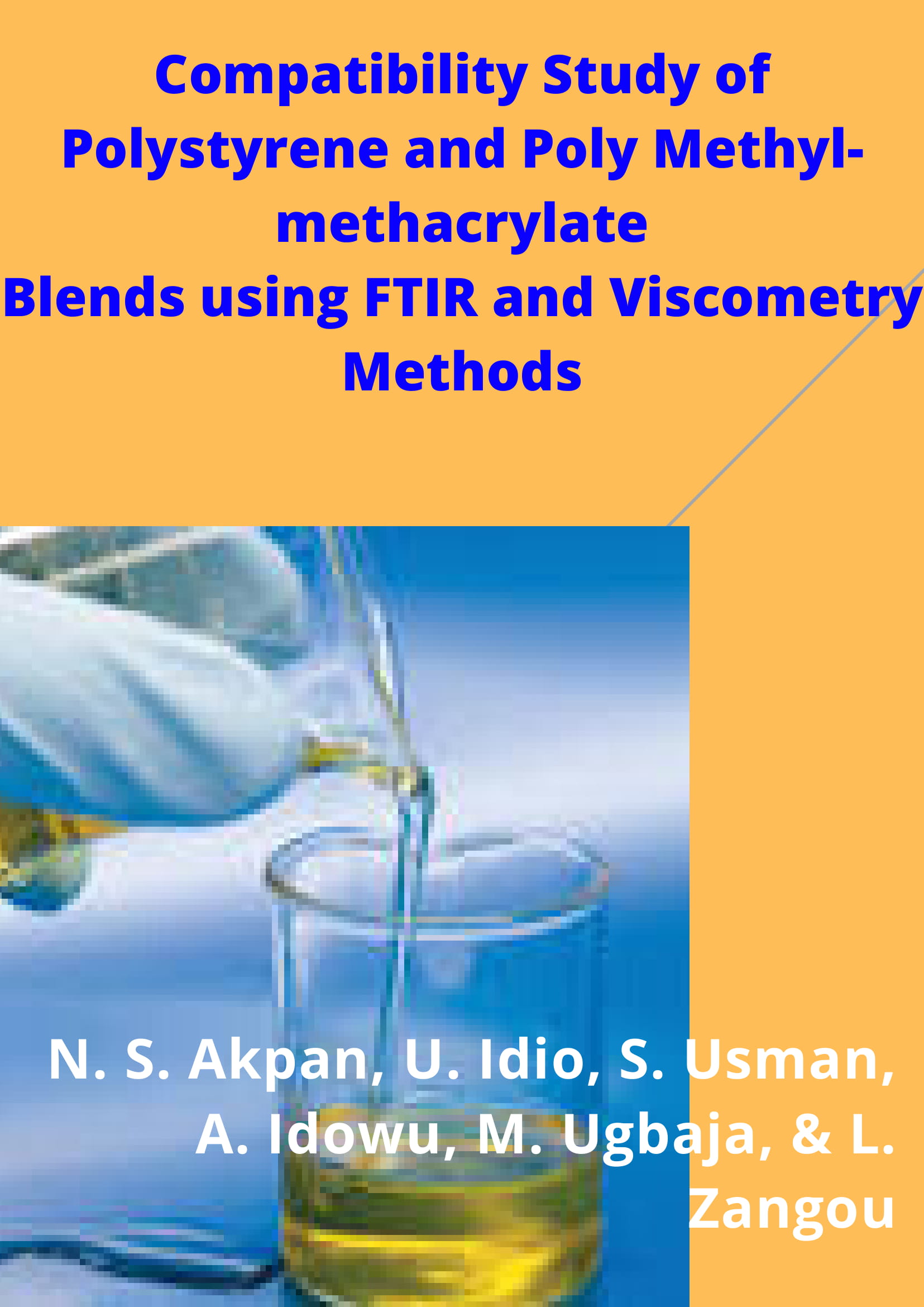Compatibility Study of Polystyrene and Poly Methyl-methacrylate Blends using FTIR and Viscometry Methods
Keywords:
Compatibility, blends, polystyrene, polymethylmethacrylate, FTIR, viscometryAbstract
Communication in Physical Sciences 2019, 4(2): 81-86
Authors: N. S. Akpan, U. Idio, S. Usman, A. Idowu, M. Ugbaja, & L. Zango
Received 03 December 2019/Accepted 29 December 2019
Polystyrene and poly(methyl - methacrylate) are widely applied polymers but suffer from some property’s failures such as brittleness, especially when used in crude form, In view of this, and other materials requirements that is expected to be met by most polymers. Thisstudy seeks to investigate compatibility of various blends of polystyrene and poly (methyl methacrylate) (in chloroform solvent) using Fourier transformed infra-red spectroscopy and viscometry methods. Results obtained from Fourier transformed infra-red spectroscopy indicated that blending did not change the functional groups of the polymers significantly, which pointed towards the existent of little or no interaction. Viscometry measurements revealed that plots of relative viscosity versus concentration, specific viscosity versus concentration and reduced viscosity versus concentration were respectively parallel to each other and assumed S-shaped which also indicated the absence of interaction, hence incompatibility. It is concluded in this work that at the operation temperature of 303 K, there is no compatibility between polystyrene and poly(methylmethacrylate) blends.

Downloads
Published
Issue
Section
Similar Articles
- Nsikak S. Akpan, Comparative Study of Blends of Polyvinyl Chloride/Poly Methyl-methacrylate and Polystyrene/Poly Methyl-methacrylate using Density, Viscometry and FTIR Methods , Communication In Physical Sciences: Vol. 5 No. 3 (2020): VOLUME 5 ISSUE 3
- S. Takuma, Assessment of changes in plasticity and mechanical properties of polystyrene fatty acid-based neem seed oil blends , Communication In Physical Sciences: Vol. 4 No. 1 (2019): VOLUME 4 ISSUE 1
- Uche Ibeneme, Kevin Ejiogu, Aiyejagbara Mosunade, Egere Chidi, Zango Leo, Onyemachi David, Mechanical and Morphological Characterization of Recycled Low Density Polyethylene and Polystyrene Blends at Varying Compositions , Communication In Physical Sciences: Vol. 11 No. 4 (2024): VOLUME 11 ISSUE 4
- Yakubu Azeh, Spectroscopic Characterization of Acetylated Wood Flakes and Its High-Density Polyethylene Blends , Communication In Physical Sciences: Vol. 8 No. 1 (2022): VOLUME 8 ISSUE 1
- Shuaibu Musa Abubakar, Aliyu Suleiman, Mohammed Abdullahi Baba, Shamsuddeen Umar Abdullahi, Aminu Adamu Bayero, Jamilu Musa Babangida, Investigation of the Effect of Gum Arabic-Rice Husk Hybrid Filler on the Mechanical Properties of Polystyrene Composite , Communication In Physical Sciences: Vol. 12 No. 7 (2025): Volume 12 issue 7
- I. Yinusa, Phytochemical Screening, GC-MS And FTIR Analysis of Ethanol Extract of Piliostigma thonningii (schum Milne—Redth) Leaf , Communication In Physical Sciences: Vol. 5 No. 1 (2020): VOLUME 5 ISSUE 1
- E. D. Paul, Casmir Emmanuel Gimba, ATR-FTIR Quantitation of Isopropyl Alcohol (IPA) and Ethanol in Some Covid-19 Targeted Hand Sanitizers in Nigeria , Communication In Physical Sciences: Vol. 7 No. 1 (2021): VOLUME 7 ISSUE 1
- M. T. Bisiriyu, Fractionation and Characterization of Asphaltenic and Resinous Fractions of Natural Bitumen , Communication In Physical Sciences: Vol. 5 No. 2 (2020): VOLUME 5 ISSUE 2
- K. G. Ta'awu, M. C. Ekanem, A. Mairo, P. G. Udofia, Sensory and market attributes of wheat-Musa. spp-soybean (WPS) flour composite bread , Communication In Physical Sciences: Vol. 5 No. 2 (2020): VOLUME 5 ISSUE 2
- Thomas Ndidi Asiwe, Idongesit Bassey Anweting, Atim Sunday Johnson, Nzikahyel Simon, Solomon Enejo Shaibu, Eco-Friendly Synthesis and Characterization of Silver and Zinc Nanoparticles Using Aqueous Extract from the Bark of Antiaris toxicaria , Communication In Physical Sciences: Vol. 12 No. 1 (2024): VOLUME 12 ISSUE 1
You may also start an advanced similarity search for this article.



